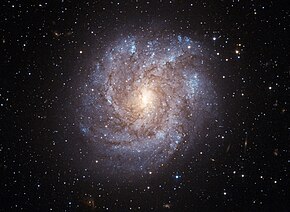NGC 2082
Appearance
| NGC2082 | |
|---|---|
 NGC 2082, as taken by theHubble Space Telescope | |
| Observation data (J2000[1]epoch) | |
| Constellation | Dorado |
| Right ascension | 05h41m50.9s |
| Declination | −64° 18′ 5″ |
| Redshift | 1184 ± 6 km/s[2] |
| Distance | 60Mly(18.4Mpc)[3] |
| Apparent magnitude(V) | 12.6[2] |
| Characteristics | |
| Type | SAB(rs+)c[2] |
| Apparent size(V) | 1.8′× 1.7′[2] |
| Other designations | |
| ESO86-21,PGC17609,HIPASSJ0541-64,IRAS05415-6419,2MASXJ05415112-6418039, SLK 499, FHW LMC B0541-6417, SGC 054136-6419.4, PSCz Q05415-6419, ISOSS J05418-6418 | |
NGC 2082is anintermediate spiral galaxyin theDoradoconstellation.[4][5]It was originally thought to be part of theDorado Groupof galaxies,[6]but was later removed.[7]It was discovered on November 30, 1834 byJohn Herschel.
SupernovaSN 1992ba,aType II,was discovered byRobert Evansin NGC 2082.[8]
See also
[edit]References
[edit]- ^"NGC 2082".DeepSkyPedia. Archived fromthe originalon 2015-06-21.Retrieved2013-06-22.
- ^abcd"NASA/IPAC Extragalactic Database".Results for NGC 2082.Retrieved28 June2013.
- ^"The dusty beauty of NGC 2082".Retrieved28 June2013.
- ^"Revised NGC Data for NGC 2082".Spider.seds.Retrieved2013-06-22.
- ^"Wikisky".Wikisky.Retrieved2013-06-22.
- ^Huchra, J. P.; Geller, M. J. (June 15, 1982). "Groups of galaxies. I - Nearby groups".Astrophysical Journal.257(Part 1): 423–437.Bibcode:1982ApJ...257..423H.doi:10.1086/160000.
- ^Maia, M. A. G.; da Costa, L. N.; Latham, David W. (April 1989)."A catalog of southern groups of galaxies".Astrophysical Journal Supplement Series.69:09–829.Bibcode:1989ApJS...69..809M.doi:10.1086/191328.ISSN0067-0049.
- ^"List of Supernovae".IAU Central Bureau for Astronomical Telegrams.Archived fromthe originalon 11 August 2015.Retrieved11 July2015.
External links
[edit] Media related toNGC 2082at Wikimedia Commons
Media related toNGC 2082at Wikimedia Commons- NGC 2082 onWikiSky:DSS2,SDSS,GALEX,IRAS,Hydrogen α,X-Ray,Astrophoto,Sky Map,Articles and images
- SEDS
